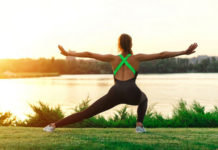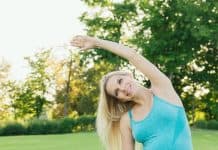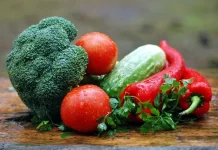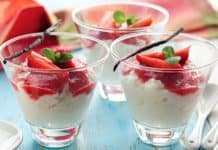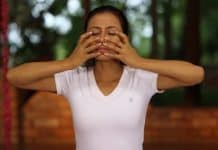The inverted backbend pose known as the “bridge pose” primarily stretches the neck, chest, and spine. In Vinyasa sequences, it is frequently employed.
This yoga pose gets the body ready for more challenging backbends. This pose improves posture and relaxes the body’s muscles in addition to increasing flexibility and strength. It aids in increasing the body’s energy.
Like many other yoga poses, the Bridge Pose got its name from the way the body is positioned. Bridge Pose is so named because the body in stance resembles a bridge.
| Pronunciation | Say-tuh Ban-dha Sarvah-angah-sana |
| Meaning | Setu – Bridge Bandha – Lock Sarva – All Anga – Limbs Asana – Pose |
| Other names | Setu Bandhasana, Kandhrasana, Shoulder Pose, Two-Legged Table, Dwi Pada Pitham |
| Pose Type | Supine, Back-bending, and stretching |
| Pose Level | Beginner, Hold for 30-60 seconds |
How to Perform Bridge Pose

Bridge Pose is simple to practice. By using the steps listed below, you may complete it quickly.
Preparing the Asana
- First, lie on your back on the ground. Your back ought to be parallel to the ground.
- Now flex your knees and bring your feet as near to your hips as you can.
Note: Knees should be pointed upward and feet should be hip-width apart.
- Put your arms beside your body.
Note: You can also use your hands to support yourself by grabbing the ankles.
Getting Into the Pose
- Firmly place your feet on the floor while inhaling, then elevate your pelvis, lower back, and middle back off the floor in that order. Lift the back using your arms as support.
Note: To properly transmit weight throughout the entire foot, the feet should be flat on the floor. Although there may be a strong urge, resist lifting your heels off the ground.
- Raising your back and hips as high as you can while maintaining a balanced weight distribution on your shoulders and feet
- When the body is sufficiently lifted, softly (don’t move it violently) tuck your chin to your collarbone towards your chest. Exhale fully after that.
The back, thighs, neck, and chest will all feel stretched out in this position. Your thighs should be parallel to the ground and your shins should be perpendicular to it.
- Now, while remaining in the same position, breathe slowly and gently. Ensure that your chest, back, and hips are raised.
Bring your attention to the flow of the prana while maintaining this pose for 30 to 60 seconds.
Releasing the Pose
- After finishing, take a few deep breaths. After there, carefully lower your entire back to the ground while exhaling.
- Now spread the legs out and unwind your entire body. For relaxation, you can also enter Savasana.
In this asana, a yoga mat is strongly advised. The asana will unquestionably become more comfortable.
Beginners Tips
Although Bridge Pose is very straightforward and basic, at first you can find it challenging to hold this pose. As a result, you can offer further support by placing a yoga block under your sacrum.
Additionally, you can elevate your back by pushing up with your hands. Place them next to your body once you have raised your back enough.
You can put a folded blanket under your shoulder, neck, and head for increased neck comfort.
Precautions and Contraindications
- Stretch to the extent permitted by your body first. Do not overextend yourself when stretching since you risk injuring yourself.
- Once your back is elevated, do not move or alter your neck because doing so could strain your neck. Come back flat to the ground to start adjusting the neck’s position. Adjust the neck as needed and return to the Bridge Pose.
- Do not execute this asana if you have a recent or severe neck or back injury, or if you have spondylitis (a spinal inflammation).
- The Bridge Pose should be avoided by anyone with migraines. A migraine sufferer may find this pose uncomfortable because it causes the blood to flow against gravity.
How does Bridge Pose Works
- Deep stretching exercises like the bridge posture primarily target the neck, back, and hips. Let’s talk about how the Bridge posture works scientifically.
- Lifting the back from the lower body puts some pressure on the feet. The thighs begin to extend after that. This pose primarily stretches the back and spine.
- The muscles along the entire back and spine are stretched when we raise the back. The core and abdomen are also stretched when the back is raised.
- The muscles of the neck and shoulders are opened as a result of the major pressure that lifts the back coming from the shoulders and neck. The neck is then sufficiently stretched once the chin is tucked into the collarbones.
- The Setu Bandha Sarvangasana stretches the body’s muscles in this manner. Let’s move on to its advantages now.
Benefits of Bridge Pose
There are numerous physical and mental health advantages to this asana. It improves general body form, increases flexibility, and strengthens the body. Here is a list of its advantages.
- The asana’s primary benefit is strengthening the spine. It exerts pressure while stretching the whole back. The back’s strength and flexibility are improved as a result.
This pose also strengthens the vertebral or spinal column muscles. This promotes the health of the spine.
- This pose strengthens the neck muscles. It relieves neck aches and straightens out the neck’s posture.
- The blood flow to the brain is increased by it. This assists in lowering stress, despair, and other unfavorable feelings.
Additionally, it enhances mood and produces feelings of excitement and contentment.
- The bridge pose stimulates the internal muscles and glands of the abdominal region by stretching the muscles of the core. The metabolism and digestive system both benefit from it.
- This pose expands the chest area, allowing the lungs to expand to their fullest potential. It promotes the respiratory system’s health.
By calming the entire chest area, also reduces hypertension, erratic blood pressure, and asthma.
- The pelvic region’s muscles are massaged and toned by the stretch in the pelvic floor. This promotes the health of the pelvic area’s organs.
Additionally, it shields women from irregularities in their menstrual cycles.
- It progressively relaxes the muscles in the legs (the calves and thighs), which is why athletes and sportspeople can benefit greatly from it.

